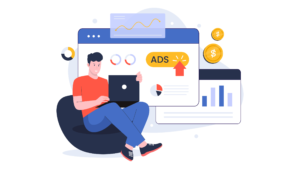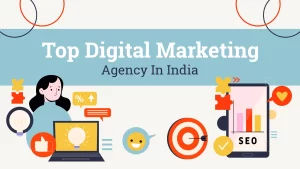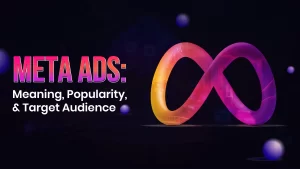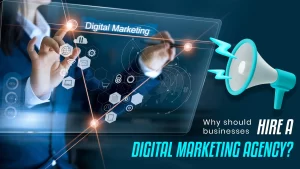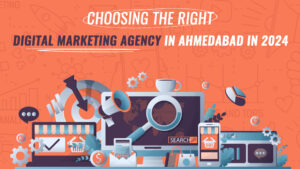As new technologies are developed, the field of digital marketing, like all others, continues to develop. To remain relevant to your audience, it’s important to stay up-to-date on advances. However, in order to properly appreciate contemporary tactics and strategies, it’s also important to comprehend the field’s past.
We’ll talk about how digital marketing has changed over time, what we think will happen to it in the future, and what we can learn from it.
Digital Marketing: What Is It?


Digital marketing is the process of using digital technologies to promote and market products or services. It can be used to reach a large audience through a variety of means, including email, social media, search engines, and website advertising.
Digital marketing has become an essential part of modern marketing strategies because of the increasing usage of digital devices and the Internet. With more people using smartphones, tablets, and laptops to access the Internet, it’s important for businesses to have a strong digital presence. By using digital marketing techniques, businesses can reach a larger audience more easily and effectively.
There are many different types of digital marketing, including search engine optimization (SEO), pay-per-click (PPC) advertising, social media marketing, email marketing, and content marketing. Each type has its own advantages and disadvantages, so it’s important to choose the right one for your business depending on your needs.
Digital marketing is constantly evolving as new technologies and platforms emerge. With the right strategy in place, your business can stay ahead of the curve and make the most of the latest digital marketing trends.
How successful is Digital Marketing?
As digitization progressed, it was noted that fewer people were buying in person in the marketplaces, and today an increasing number of individuals are doing so for themselves and their families. Because you want to reach the correct audience, and that audience is online, there are several benefits to advertising your business online.


In the 1990s, the phrase “digital marketing” initially appeared. With the advent of the internet and the creation of the Web 1.0 platform, the digital era truly began. Users of the Web 1.0 platform could obtain the information they needed, but they were unable to distribute it online. Marketers all around the world were still wary of the digital platform up to that point. Since the internet had not yet experienced widespread adoption, they were unsure if their techniques would be successful.
After the first clickable banner went up in 1993, HotWired bought a number of them to use in their advertising. This signaled the start of the shift from traditional marketing to digital marketing. This slow transformation allowed new technologies to join the digital market in 1994. Yahoo was introduced in the same year.
Yahoo, which was founded by Jerry Yang and is also known as “Jerry’s Guide to the World Wide Web,” generated about 1 million hits in its first year. As a result, businesses optimized their websites to get higher search engine rankings, causing a radical shift in the digital marketing landscape. In 1996, a few other search engines and tools, including HotBot, LookSmart, and Alexa, were introduced.
In 1998, Google started to exist. Yahoo introduced Yahoo web search, whereas Microsoft introduced the MSN search engine. After the internet bubble burst two years later, all of the smaller search engines were either left behind or eliminated, making room for the industry’s titans. The field of digital marketing had its first significant upswing in 2006 when it was estimated that search engine traffic had increased to roughly $6.4 billion in only one month. Microsoft established Live Search to take on Google and Yahoo, putting MSN on hold in order to keep up.
When Web 2.0 arrived, individuals started taking an active role in the platform rather than just using it passively. Web 2.0 facilitates communication between customers and companies. The internet started to be given names like “super information highway.” Due to the massive rise in information flow volumes—including the channels used by digital marketers—internet advertising and marketing in the US alone generated $2.9 billion in revenue by 2004.
Social networking websites soon started to appear. The first social networking website was MySpace, which was quickly followed by Facebook. Many businesses understood that the influx of brand-new websites was starting to create more options for them to sell their goods and brands. It opened up new commercial opportunities and heralded the start of a new era for the industry. With additional resources, they required fresh ideas for brand promotion and social networking platform exploitation.
In the field of digital marketing, the cookie was another significant turning point. The nascent technology has prompted marketers to start looking for alternative revenue streams. One such method was keeping tabs on regular internet users’ surfing patterns and user habits in order to customize marketing materials and promotions to their preferences. The original cookie’s purpose was to keep track of user behaviors. Over time, the cookie’s function has evolved, and modern cookies are programmed to give advertisers a number of options for gathering actual user data.
Customers may now access digitally advertised goods at any time. According to data gathered by the Marketingtechblog for 2014, social media posting is the most popular online activity in the US. The typical American uses social media for 37 minutes every day. 97% of digital marketers use Twitter, 69% use Pinterest, and 59% use Instagram. Facebook is used by 99% of them. Facebook has been a source of consumers for 70% of B2C marketers. The likelihood that 67% of Twitter users will make a purchase from a company is significantly higher. Luxury brands are represented on Pinterest in 83.8% of cases. LinkedIn, Twitter, and Facebook are the top three social media platforms used by marketers.
Evolution of Digital Marketing – The Timeline
The 90s
Early in the 1990s, Archie, the first search engine, made its appearance, kicking off the search era. Quickly after came SEO, or search engine optimization.
In 1994, the first clickable online banners were released. With 3.5 million users upon debut, the first recognizable social networking platform was founded in 1997. Many websites that are still in use today were discovered in the 1990s, including Google and Yahoo’s web searches, both of which launched in 1998.
The Millennial Generation
In the new century, a significant economic bubble formed. However, many firms were hurt as the bubble peaked and deflated between 2000 and 2002. As the economy recovered from the boom, several new websites were founded in the 2000s, including LinkedIn in 2002, Myspace and WordPress in 2003, and Facebook in 2004. Mobile text message marketing grew in popularity in the early 2000s.
The Mobile Era
Increased marketing and sales were seen in the second part of the decade, with Amazon’s e-commerce sales reaching $10 billion. With the advent of Whatsapp, Instagram, and Snapchat to the online community during the following several years, mobile app culture grew.
The State of Digital Marketing Right Now


Digital marketing is essentially the process of advertising goods and services online. The objective is to increase public knowledge of your brand and products, just like with conventional marketing.
Prior to the development of digital marketing techniques, firms only used offline methods. Billboards, TV and radio advertisements, newspapers, direct mail, phone calls, postcards, catalogs, brochures, and other print media were some of the channels that were used to advertise.
Some of these conventional marketing strategies are still successful today when so many businesses are vying for clients. For instance, older audiences of a brand could feel more at ease reading hard copies of newspapers than their digital equivalents. Radio advertising is still around.
The extent of their reach, however, is one of the key distinctions between the two kinds. Advertising on the radio or in the newspaper may be useful for reaching nearby consumers. But if you want to promote internationally, digital strategies are your best chance. They may also be more affordable than their conventional competitors.
Tweets, videos, podcasts, emails, blog posts, Pay-Per-Click (PPC) advertising, and other forms of digital marketing are all possible. Nearly 45% of the world’s population, or roughly 3.5 billion people, use social media, demonstrating the reach of digital marketing.
Today, 65% of an individual’s digital media time is spent on a mobile device. The digital advertising industry is now valued at around $200 billion, with Google Ad Words accounting for 96% of the company’s revenue. With an estimated 3.1 billion online users, social networking has led the digital marketing revolution. The rise of bloggers and Instagram has resulted in a $1 billion industry for influencers, which is anticipated to grow. Digital marketing is expected to grow in the coming years, with many new developments and changes in this exciting industry.
Marketing to younger generations is also getting harder and harder. Getting people to decide and purchase might be quite difficult. You can eventually reach them and sell to them thanks to your digital marketing activities. In general, digital platforms provide considerably better options to interact with and keep in contact with your audience.
The Future of Digital Marketing is Much Larger
Analytics


Digital marketing analysis is often performed after the fact. Marketers will, for example, post a piece of content and then measure its effectiveness after a few weeks. This is obviously beneficial, but real-time analytics is beginning to shake up the world of digital marketing. The real-time analysis enables marketers to both individualize information for smaller segments of customers and respond to their performance much more swiftly.
Social Media Influencers
Advertisers from different industries are collaborating with social media influencers to strengthen their businesses. This is proven to be a successful digital marketing tactic, owing to the fact that customers trust other consumers more than firms selling items. Expect more firms to employ influencers to promote sales in 2023 and beyond.
Expect to see fewer celebrities pushing things, as customers have grown tired of their endorsements. Instead, the trend is shifting toward influencers who have a more direct connection to the product. One outstanding example is make-up artist James Charles, who has become a celebrity but also has cosmetics skills, and whom Cover Girl has enlisted for promotional purposes.
Video will Remain King
As digital marketers leverage people’s short attention spans and desire to see material rather than read it, video will remain a top technique in 2023. Because 74 percent of US consumers view internet videos each week, this medium will continue to play an important role in connecting customers and companies. Most social networking platforms allow you to host and share videos.
SEO for photos and videos is one trend to keep an eye on. Typically, individuals put in terms related to a certain image or video, but this may be time-consuming. More and more individuals are realizing that they may search for other, roughly comparable photographs online using current or new images. This significantly broadens the reach of digital marketing. Advertisers may help potential consumers discover them by inserting relevant keywords in the titles of their photos and videos, providing alt text in image descriptions, and utilizing other tactics.
Artificial Intelligence


Artificial intelligence (AI) allows digital marketers to better evaluate user data and tailor the client journey. AI enables businesses to learn a lot about their consumers and how to effectively target them.
AI also gives consumers a more personalized experience, offering tailored support at each stage of the purchasing process. Businesses may attain this level of customer service by automating adverts to specific audiences using programmatic advertising.
Augmented and Virtual Reality
Businesses will continue to use augmented reality (AR) and virtual reality (VR) in their marketing efforts in order to increase brand recognition and meet client demand. Companies such as Starbucks, Nivea, and Volkswagen have successfully implemented AR and VR campaigns to provide customers with an experience that ties them to their brands and goods.
Content to Become More Interactive
Although interactive content is not new, it is becoming more popular as an effective marketing tool than ever before. They not only extend the length of time a prospective consumer spends interacting with your business, but they also allow you to collect additional data and, as a result, fine-tune your digital marketing plan.
To broaden the scope of digital marketing, interactive content might include contests (for example, “comment on this article and share it to your timeline to participate”), polls, surveys, or even games. Giving people new ways to connect with your business contributes to the overall objective of increased customization.
Bottom Line
Finally, this demonstrates how digital marketing has grown over the past year. Still, history indicates that as soon as the social media frenzy began and Google established a stranglehold in the digital ads arena, the need for digital marketing skyrocketed. It appeared that the new revolution would leave traditional marketing in the dust. But, in response to the question, “Is digital marketing an evolution or a revolution?” ‘is inside you. Your conscience is the only one who can answer the question.


